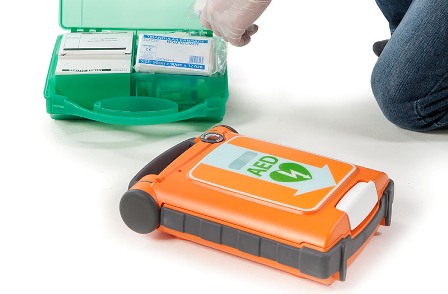How do AEDs/ Defibrillators Function?
Date: Friday, 15 May 2015. -
Blog, Defibrillators, Courses
We’ve all heard it. That dreadful, infinite beep of somebody ‘flat-lining’ on the television, their desperate family sobbing whilst wrestling with hospital staff to be at their side, a flurry of people entering and placing pads on the patient’s chest “Shocking in 3 2 1... CLEAR.” The jolt of the patient’s body as they are miraculously brought back to life.
I imagine that the majority of people in the UK have only ever seen defibrillators on episodes of Casualty or ER and television programmes do not always give an accurate representation. Therefore, this post has been created with the aim to banish some of the myths associated with defibs and to give people a greater understanding of how they operate.
The Facts
- Once the pads have been applied to the victims chest a defib will analyse whether a shock is needed. The machine will ONLY release a shock if the heart impulses are irregular.
- Irregular heart impulses are called Ventricular Tachycardia or Ventricular Fibrillation which cause the heart to quiver and prevent it from pumping oxygenated blood around the body.
- A defib does not restart the heart. However, it stops the irregular rhythm from occurring in the hope that the heart’s mechanics will return the electrical impulses and pulse rate to normal.
- There are two types of Defib, semi- automatic and fully automatic. The semi-auto defib has a shock button to press when a shock is advised. The fully-auto defib will analyse the patient, announce if a shock is advised, advise bystanders to clear the area and then shock the patient automatically.
- When the shock is released it allows the victims heart to restore its normal rhythm. However, it doesn’t always work first time. The defib will talk you through whether you need to continue with CPR.
- Defibs have voice prompts aided by a visual stimulus to talk you through the process. In effect, you could carry out defibrillation easily even if you had never seen one before.
- Defibs will often have two types of pads or a switch to alternate between an adult or a child aged 1-8 years old. This is because the paediatric function with release lower levels of energy.
- The Defib will perform regular self-checks. If any problems are found the defib will inform you via an audible alarm or flashing indicator.
- There are different types of defib for different environments determined by the IP rating. Defibs with a low IP rating such as IP21 don’t have a great resistance to dust or water, making them more suitable for an office environment. Whereas defibs with a high IP rating such as IP55 have a high tolerance to dust and water suiting a leisure centre or outdoors.

Some people worry that defibrillators will do more harm than good, but they are the only definitive treatment for sudden cardiac arrest. CPR is used only to preserve life long enough to acquire a defib- it is not an effective cause of treatment.
In the past, we have actually had some instances when companies have purchased an AED and then when they needed to use it to administer that life-saving shock they felt too intimidated by the equipment.
Defibrillators are easy to use with the voice and visual prompts taking you through every step of the process, but we also understand the importance of familiarising yourself with the kit so that you will feel confident enough to use it.
It’s like buying any new piece of technology; for instance, when you get a new mobile phone and you spend hours trying to figure out how to turn on the Wi-Fi or install Apps, completely ignoring the instruction manual. Some people learn by doing.
This is why we offer AED courses to allow our learners to immerse themselves in the world of defibrillators; to ask questions and to practice using the kit so that they will not only have confidence in the device but in themselves to administer the defibrillation process correctly.
Why invest in a defib if you aren’t going to use it? Please take into consideration that for every minute that passes a victim of sudden cardiac arrest loses 10% of their survival chances. Can you really afford to wait for further assistance?
For more information on defibrillators, have a flick through our Buyers Guide. If you need any advice then give a member of our team a call on 0843 309 4551.
